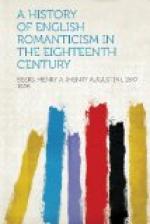“Chatterton,” testifies one of his early acquaintances, “was fond of walking in the fields, particularly in Redcliffe meadows, and of talking of his manuscripts, and sometimes reading them there. There was one spot in particular, full in view of the church, in which he seemed to take a peculiar delight. He would frequently lay himself down, fix his eyes upon the church, and seem as if he were in a kind of trance. Then on a sudden he would tell me: ’That steeple was burnt down by lightning: that was the place where they formerly acted plays.’” “Among his early studies,” we are told, “antiquities, and especially the surroundings of medieval life, were the favorite subjects; heraldry seems especially to have had a fascination for him. He supplied himself with charcoal, black-lead, ochre, and other colors; and with these it was his delight to delineate, in rough and quaint figures, churches, castles, tombs of mailed warriors, heraldic emblazonments, and other like belongings of the old world."[5]
Is there not a breath of the cloister in all this, reminding one of the child martyr in Chaucer’s “Prioresse Tale,” the “litel clergeon, seven yeer of age”?
“This litel child his
litel book lerninge,
As he sat in the scole at
his prymer,
He ‘Alma redemptoris’
herde singe,
As children lerned hir antiphoner.”
A choir boy bred in cathedral closes, catching his glimpses of the sky not through green boughs, but through the treetops of the Episcopal gardens discolored by the lancet windows of the clear-stories; dreaming in the organ loft in the pauses of the music, when
“The
choristers, sitting with faces aslant,
Feel the silence to consecrate
more than the chant.”




